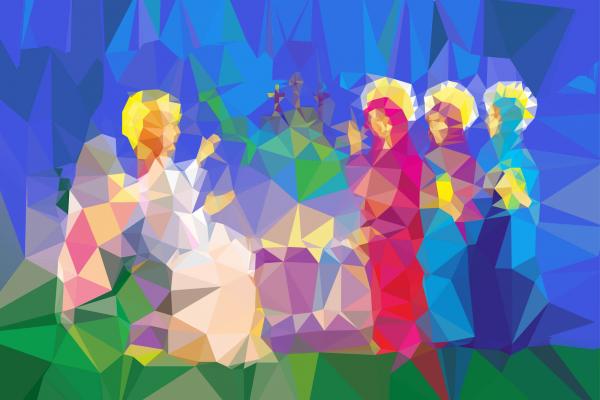On the first day of the week, very early in the morning, the women took the spices they had prepared and went to the tomb. They found the stone rolled away from the tomb, but when they entered, they did not find the body of the Lord Jesus. While they were wondering about this, suddenly two men in clothes that gleamed like lightning stood beside them. In their fright the women bowed down with their faces to the ground, but the men said to them, "Why do you look for the living among the dead? He is not here: He has risen!" (Luke 24:1-6)
Imagine what these women — these followers of Jesus — must have felt as they heard the best news in the history of the world.
In so many of the gospel stories that are familiar to us, women were behind the scenes — always there, always present, always faithful — but nearly always in the background and hardly ever mentioned by the men in the stories, and certainly not the ones writing the stories. Their testimony as women was not even admissible in court under Jewish law; the word of a woman had no public credibility in that patriarchal culture. But God chose to reveal the miracle of Jesus' resurrection first to women. They were then told to report the astonishing news of the empty tomb to the men.
Jesus' first appearance was also to a woman: Mary Magdalene. She was in the garden near the tomb, stricken with grief. The one who had accepted and forgiven her, the one whom she loved so deeply, was gone. She saw a figure she thought was the gardener and said to him, "They have taken my Lord. Do you know where they have laid him?" Then a familiar voice called her name, "Mary." She looked up and recognized him. "Master!" she cried. Her Lord had come back, and the heart of the woman who had been cleansed by his love leapt for joy. Mary went straight to the disciples with a simple testimony, “I have seen the Lord.” Again, the male disciples hearing the greatest news in history and for the future of their lives from Mary was itself a powerful sign of the purposes of God.
On that first Easter morning, the women were present at great risk to themselves. They were at the grave of a convicted political criminal who had just been crucified. The guards posted at the tomb could easily have reported the identities of any followers or supporters of this one whom they had killed and whose movement they now hoped to crush.
The risk of the women is made even more dramatic by the realization that the rest of the disciples were all laying low. The men were hiding, paralyzed by grief and fear.
The women at the tomb have always reminded me of other women, like the Mothers of the Disappeared in Latin America, who in country after country were the ones who — when things were at their worst, when the violence of military-ruled countries was most grotesque, when the suffering was so horrible — came out time and time again and stood alone before the military and before the world, testifying for their loved ones, and for the truth. Women also put their lives on the line and played key roles in the transformations in many African countries, the peace movement in Northern Ireland, and in the hopeful beginnings of the Arab Spring protests.
I also think of the women at the tomb when I think of the Mothers of the Movement — mothers of young men and women of color who have died at the hands of law enforcement, while in police custody, or as the result of gun violence. We know the names of their children: Trayvon Martin, Michael Brown, Sandra Bland, Eric Garner, Hadiya Pendleton, Dontre Hamilton, Jordan Davis, and so many more. Their powerful testimonies on behalf of criminal justice reform, racial justice, and commonsense gun control speak of the power of these women to raise their voices for justice and hope in the face of unspeakable personal tragedy.
We have also seen women disproportionately leading the broader Black Lives Matter movement, often on the front lines of protests where police in military gear have been all too willing to use force against overwhelmingly nonviolent protestors.
The Women’s Marches all over the world the day after Donald Trump’s inauguration were a harbinger of what has happened since. Statistics are emerging that suggest that women form the clear majority of the resistance to some of the most harmful and dangerous agendas of the new administration.
We have seen it in so many places: When things get rough, when things are at their worst, when everyone else flees or is in hiding, very often it is the women who stand up, offering themselves, becoming completely vulnerable as they submit to the risk of death. That is indeed their strength and their power.
So here in the resurrection event is the pivotal moment in all history. The male disciples have fled and are hiding, and only the women are left. And they come not without fear, the gospel story tells us, but they come out of love and faith. They were faithful to Jesus in all of his life, and in his death, and now even after his death. Out of their love for him, they are going to minister to him even at the tomb.
For their loving perseverance and courage, these women are rewarded with the honor of being entrusted with the most important news in the history of the world. These women, and many women who have come after them, can rightly be called history's midwives of hope. And they become for us, on the resurrection morning of Easter, the primary example in the story of what we too are called to be — midwives of hope.
What does it mean to be a midwife of hope? The word hope is so often used in ways that are mostly mystical or rhetorical — politically or otherwise — or so religious that the meaning escapes the world. It somehow escapes the reality in which we have to live.
Hope becomes a feeling, or a mood, or an inspired moment that is lived somehow above the painful and the dull agonies of history. We're down here living in it all, and someone says, "Well, you have to have hope." And right away we think, "I'm supposed to feel something I'm not feeling — to get into a mood that isn't natural to me. I need to rise above this daily reality somehow and be hopeful." But the more I wrestle with this word "hope," the more I am convinced that we must see hope in a different, and indeed a more biblical, way.
You see, hope is not simply a feeling, or a mood, or a rhetorical flourish. It is a choice, a decision, an action based upon faith. Hope is the very dynamic of history. Hope is the engine of change. Hope is the energy of transformation. Hope is the door from one reality to another.
Things that seem possible, reasonable, understandable, even logical in hindsight — things that we can deal with, things that don't seem extraordinary to us — often seemed quite impossible, unreasonable, nonsensical, and illogical when we were looking ahead to them. The changes, the possibilities, the opportunities, the surprises that no one or very few would even have imagined, just become history after they've occurred. What looked before as though it could never happen is now easy to understand.
The news from the women at the tomb was the greatest hope that the world has ever known. And yet what did the disciples call it? "Nonsense."
Hope unbelieved is always considered nonsense. But hope believed is history in the process of being changed. The nonsense of the resurrection became the hope that shook the Roman Empire and established the Christian movement. The nonsense of slave songs in Egypt and Mississippi became the hope that let the oppressed go free. The nonsense of a bus boycott in Montgomery, Ala, became the hope that transformed a nation.
This is also how personal transformation takes place. We can't imagine ourselves different than we are today or healed of that which binds and afflicts us. We can't imagine ourselves forgiven. We can't imagine our own salvation. But when we walk through the door of hope, and we look back at where we have been and where we are now, we see evidence of the grace of God.
For Christians the Resurrection is that door of hope, and Jesus showed us that the resurrection comes by way of a cross. Suffering and hope are always joined in human history. The cost of moving from one reality to another — in our personal lives and in history — is always great. But it is the only way to walk through the door of hope.
History depends on those who are willing to walk through that door, those who live and act and even die in hope for the sake of the future they know by faith is there — those such as the women at the tomb who were given the news of the resurrection. They were given the news of the resurrection because they opened the door for all the rest of us.
On Easter morning we stand on the knowledge of the resurrection. We stand on the faith of those who have been given the news of the resurrection before us.
It is not nonsense to believe that weapons of mass destruction are not necessary, and that war is not inevitable. It is not nonsense to believe that a child's race and class and sex will not always determine their future share of happiness and well-being. It is not nonsense to believe that we who have been divided from each other can, and will, one day sit down together at the welcome table of God's love and God's grace.
These are not nonsense thoughts. With the Easter eyes of resurrection faith, we can see the door through which we too can walk, through which we are invited, where we also will be given the news of the resurrection.
And with this hope, sisters and brothers, we can know our sins forgiven, and our lives made whole. We can look into the faces of our children and believe there is a future for them.
With this hope we can look into the eyes of the poor, the suffering, and the dispossessed and believe that God is able to establish justice for all. With this hope we can together build new communities of faith that will someday overcome the barriers of race and class and gender. And with this hope we can even look forward to a day when our nation no longer measures its security by its weapons, and its status by its wealth.
With this hope we can envision an America finally able to live without racism and without oppression, but no longer able to live without justice and compassion. With this hope we can plan and sow and build and create visions and dreams. And with this hope we can find the faith and the courage to bear the cost of such possibilities.
So with all this in mind, we prepare to hear this Sunday, "Why do you look for the living among the dead? He is not here; he has risen!" Amen.
Got something to say about what you're reading? We value your feedback!

